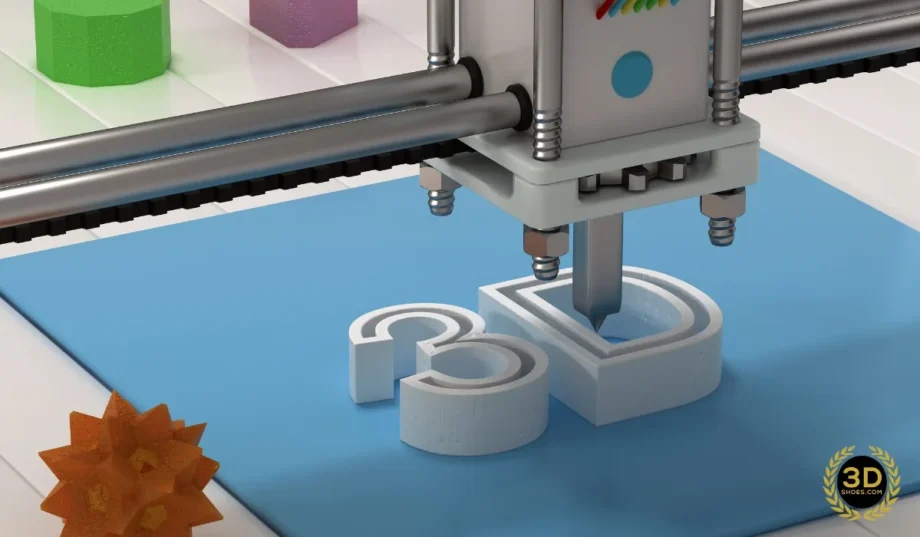Imagine walking in a pair of shoes that are not just stylish but perfectly tailored to your feet, produced with minimal waste, and designed to last. This isn’t a distant future dream—it’s the reality brought to life by 3D printing in footwear. In recent years, 3D printing has revolutionized various industries, and the footwear industry is no exception. This article delves into the numerous benefits of using 3D printing in footwear design and production, showing how this technology is reshaping the way we think about shoes.
What is 3D Printing?
Before diving into the specifics of how 3D printing benefits the footwear industry, let’s take a moment to understand what 3D printing actually is. At its core, 3D printing, also known as additive manufacturing, is a process where a digital design is turned into a physical object by adding material layer by layer. Unlike traditional manufacturing methods that often involve cutting away material (subtractive manufacturing), 3D printing builds up an object from nothing but the raw materials.
The concept of 3D printing isn’t new—it dates back to the 1980s—but its application in industries like healthcare, automotive, and now footwear, has grown exponentially in recent years. As technology advances, 3D printing is becoming more accessible and versatile, opening up new possibilities for innovation.
The Intersection of 3D Printing and Footwear Design
3D printing and footwear design have proven to be a match made in heaven. Major brands like Adidas, Nike, and New Balance have already embraced this technology, using it to create innovative shoe designs that were once thought impossible. From midsoles that provide unparalleled cushioning to uppers with intricate lattice structures, 3D printing allows designers to push the boundaries of creativity and functionality.
This technology enables designers to experiment with complex geometries and materials that would be difficult or impossible to produce with traditional manufacturing methods. As a result, consumers get shoes that are not only aesthetically pleasing but also optimized for performance.
Customization and Personalization
One of the most exciting benefits of 3D printing in footwear is the ability to customize and personalize shoe designs. Traditional shoe manufacturing often involves producing large quantities of standardized sizes and styles. However, not everyone’s feet are the same, and this is where 3D printing comes in.
With 3D printing, shoes can be tailored to the exact measurements and preferences of the individual. Whether it’s adjusting the arch support, width, or even creating a completely unique design, 3D printing makes it possible to produce a pair of shoes that fit like a glove—or, in this case, like a sock. This level of personalization isn’t just a luxury; it can also address specific needs, such as providing better support for athletes or creating orthopedic footwear for people with foot issues.
Speed and Efficiency in Production
Time is money, and in the world of footwear production, speed is crucial. Traditional shoe manufacturing can be a time-consuming process, involving multiple steps from design to final product. In contrast, 3D printing streamlines this process, allowing for quicker turnaround times.
Once a design is finalized, it can be sent to a 3D printer and produced in a matter of hours. This speed is particularly beneficial for companies looking to bring new designs to market quickly or produce limited-edition runs. Moreover, it enables rapid prototyping, where multiple iterations of a design can be created, tested, and refined in a fraction of the time it would take with conventional methods.
Sustainability in Footwear Production
As consumers become more environmentally conscious, the demand for sustainable products is growing. Fortunately, 3D printing offers significant sustainability benefits in footwear production. Traditional manufacturing methods often result in a considerable amount of waste, as excess materials are cut away and discarded. In contrast, 3D printing uses only the material needed to create the product, drastically reducing waste.
Moreover, 3D printing allows for the use of eco-friendly materials, such as biodegradable or recyclable filaments, further reducing the environmental impact. Some companies are even experimenting with printing shoes using materials derived from renewable resources, such as plant-based polymers. By adopting 3D printing, the footwear industry can take a significant step towards a more sustainable future.
Cost-Effectiveness
While the initial investment in 3D printing technology can be substantial, the long-term cost benefits are undeniable. For manufacturers, 3D printing reduces the need for expensive molds and tooling, which are typically required in traditional shoe production. This reduction in upfront costs, combined with the efficiency of the production process, translates to lower overall production costs.
For consumers, this could mean more affordable footwear in the long run. Additionally, the ability to produce shoes on demand reduces the need for large inventories, further cutting down on costs associated with storage and overproduction. In an industry where margins can be tight, 3D printing offers a way to maintain profitability while delivering high-quality products.
Innovative Design Possibilities
3D printing opens up a world of innovative design possibilities that go beyond the limitations of traditional manufacturing. With 3D printing, designers can create intricate patterns, textures, and structures that would be impossible or too costly to produce using conventional methods.
For instance, Adidas’ Futurecraft 4D shoes feature a 3D-printed midsole made from a lattice structure that provides targeted support and cushioning. This design would be nearly impossible to achieve with traditional manufacturing methods. Similarly, New Balance has used 3D printing to create customized spike plates for athletes, optimizing performance based on individual needs.
These examples highlight how 3D printing allows for the creation of shoes that are not only functional but also visually striking, setting new standards in footwear design.
Prototyping and Testing
Prototyping is a critical step in footwear design, allowing designers to test and refine their ideas before committing to mass production. 3D printing excels in this area, enabling rapid prototyping that saves both time and money.
With traditional prototyping methods, creating a single prototype could take weeks and cost thousands of dollars. 3D printing, on the other hand, allows for the creation of multiple prototypes in a matter of days, at a fraction of the cost. This speed and affordability make it easier to experiment with different designs, materials, and structures, leading to better end products.
Moreover, 3D-printed prototypes can be tested in real-world conditions, providing valuable feedback that can be used to fine-tune the design before it goes into full-scale production. This iterative process ensures that the final product is both high-quality and well-suited to the needs of the consumer.
Comfort and Fit
Comfort and fit are paramount when it comes to footwear, and 3D printing offers significant advantages in these areas. By allowing for precise customization, 3D printing ensures that each shoe is tailored to the exact dimensions of the wearer’s feet, providing a level of comfort that off-the-shelf shoes simply can’t match.
Additionally, advances in 3D printing technology have made it possible to produce shoes with varying degrees of flexibility, cushioning, and support. For example, a runner might require more cushioning in the heel, while someone with flat feet might need extra arch support. 3D printing allows these specific needs to be addressed in the design and production process, resulting in shoes that offer superior comfort and performance.
Durability and Performance Enhancement
Durability is another area where 3D printing shines. By using advanced materials and design techniques, 3D-printed shoes can be made to withstand the rigors of daily wear and tear. This is particularly important for athletic footwear, where durability and performance go hand in hand.
For instance, some 3D-printed shoes incorporate reinforced structures in high-wear areas, such as the sole or toe box, to enhance durability. Additionally, the ability to fine-tune the design means that performance features, such as traction patterns or shock absorption, can be optimized for specific activities, from running to hiking.
Challenges in 3D Printing for Footwear
While 3D printing offers numerous benefits, it’s not without its challenges. One of the primary limitations is the current cost of 3D printing technology, which can be prohibitive for smaller companies or startups. Additionally, the range of materials that can be used in 3D printing is still somewhat limited, which can restrict design possibilities.
Another challenge is the speed of production. While 3D printing is faster than traditional methods in many cases, it’s not yet capable of producing shoes at the same scale as traditional manufacturing. This means that for now, 3D printing is often used for limited-edition runs or custom orders, rather than mass production.
However, as technology continues to evolve, these challenges are likely to be overcome, making 3D printing an even more viable option for footwear production in the future.
Impact on the Footwear Industry
The impact of 3D printing on the footwear industry is already significant and is expected to grow in the coming years. For large companies, 3D printing offers a way to innovate and stay ahead of the competition. For smaller companies and startups, it provides an opportunity to enter the market with unique, customizable products.
Additionally, 3D printing is democratizing the design process, allowing independent designers and even consumers to create their own shoes. This shift is likely to lead to a more diverse and vibrant footwear market, where creativity and individuality are valued.
Future Trends in 3D-Printed Footwear
Looking ahead, the future of 3D-printed footwear is bright. As technology continues to advance, we can expect to see even more innovative designs and applications. For instance, the integration of smart materials and sensors into 3D-printed shoes could lead to footwear that adapts to the wearer’s movements or provides real-time feedback on performance.
Consumer demand for sustainability and customization is also likely to drive further adoption of 3D printing in the footwear industry. As more companies recognize the benefits of this technology, we may soon reach a point where 3D-printed shoes are the norm rather than the exception.
Conclusion
3D printing is revolutionizing the footwear industry, offering a host of benefits that range from customization and speed to sustainability and cost-effectiveness. As technology continues to evolve, the potential for 3D printing in footwear is virtually limitless. Whether you’re a designer, a manufacturer, or a consumer, 3D printing promises to reshape the way we think about shoes, making them more personalized, sustainable, and innovative than ever before.
FAQs
1. How long does it take to 3D print a pair of shoes?
The time it takes to 3D print a pair of shoes varies depending on the complexity of the design and the type of 3D printer used. On average, it can take anywhere from a few hours to a full day.
2. Are 3D-printed shoes durable?
Yes, 3D-printed shoes can be very durable, especially when advanced materials and reinforcement techniques are used. However, durability may vary depending on the design and materials.
3. Can 3D printing be used for all types of footwear?
While 3D printing is versatile, it’s currently best suited for certain types of footwear, such as athletic shoes, customized orthotics, and fashion-forward designs. As technology improves, its application will likely expand.
4. How does 3D printing affect the cost of shoes?
3D printing can reduce costs by eliminating the need for molds and reducing material waste. However, the initial investment in 3D printing technology can be high. Over time, these savings can result in more affordable footwear.
5. What are the environmental benefits of 3D-printed shoes?
3D printing is more sustainable than traditional manufacturing methods as it reduces material waste and allows for the use of eco-friendly materials. Additionally, on-demand production reduces the need for large inventories, further decreasing the environmental impact.




